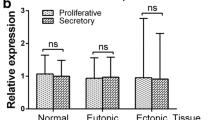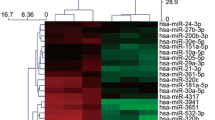Abstract
Introduction
Focal adhesion kinase (FAK) is a critical mediator of extracellular matrix signaling, cell survival, proliferation and motility. Twist homolog 1 (TWIST1) is a transcription factor and serves as a powerful oncogene. Increased FAK and TWIST1 expression are observed in a variety of solid human tumors and correlate with metastasis and poor survival.
Materials and methods
Here, we identify miR-543 as a direct regulator of FAK and TWIST1 expression in endometrial cancer.
Results
Forced expression of miR-543 in endometrial cancer cell lines decreases both endogenous FAK and TWIST1 mRNA and protein levels. Forced expression of miR-543 in aggressive endometrial cancer cell lines also impairs tumor cell monolayer proliferation, anchorage-independent growth, migration and invasion. Endogenous miR-543 expression is decreased in malignant versus normal endometrium tissue and the levels of miR-543 inversely correlate with mRNA levels of FAK and TWIST1.
Conclusions
miR-543 expression is decreased in endometrial cancer and serves as a tumor suppressor by targeting FAK and TWIST1 expression.






Similar content being viewed by others
Abbreviations
- FAK:
-
Focal adhesion kinase
- TWIST1:
-
Twist homolog 1
- miRNA:
-
MicroRNA
- BrdU:
-
5-Bromo-2-deoxyuridine
- EMT:
-
Epithelial mesenchymal transition
References
Mutz-Dehbalaie I, Egle D, Fessler S, Hubalek M, Fiegl H, Marth C, Widschwendter A (2012) HE4 is an independent prognostic marker in endometrial cancer patients. Gynecol Oncol 126(2):186–191. doi:10.1016/j.ygyno.2012.04.022
Amant F, Moerman P, Neven P, Timmerman D, Van Limbergen E, Vergote I (2005) Endometrial cancer. Lancet 366(9484):491–505. doi:10.1016/S0140-6736(05)67063-8
Kitchener H (2006) Management of endometrial cancer. Eur J Surg Oncol: J Eur Soc Surg Oncol Br Assoc Surg Oncol 32(8):838–843. doi:10.1016/j.ejso.2006.03.046
Bartel DP (2009) MicroRNAs: target recognition and regulatory functions. Cell 136(2):215–233. doi:10.1016/j.cell.2009.01.002
Ma L, Teruya-Feldstein J, Weinberg RA (2007) Tumour invasion and metastasis initiated by microRNA-10b in breast cancer. Nature 449(7163):682–688. doi:10.1038/nature06174
Poliseno L, Salmena L, Riccardi L, Fornari A, Song, Hobbs RM, Sportoletti P, Varmeh S, Egia A, Fedele G, Rameh L, Loda M, Pandolfi PP (2010) Identification of the miR-106b ~ 25 microRNA cluster as a proto-oncogenic PTEN-targeting intron that cooperates with its host gene MCM7 in transformation. Sci signal 3(117):ra29. doi:10.1126/scisignal.2000594
Ma L, Young J, Prabhala H, Pan E, Mestdagh P, Muth D, Teruya-Feldstein J, Reinhardt F, Onder TT, Valastyan S, Westermann F, Speleman F, Vandesompele J, Weinberg RA (2010) miR-9, a MYC/MYCN-activated microRNA, regulates E-cadherin and cancer metastasis. Nat Cell Biol 12(3):247–256. doi:10.1038/ncb2024
Tavazoie SF, Alarcon C, Oskarsson T, Padua D, Wang Q, Bos PD, Gerald WL, Massague J (2008) Endogenous human microRNAs that suppress breast cancer metastasis. Nature 451(7175):147–152. doi:10.1038/nature06487
Kyo S, Sakaguchi J, Ohno S, Mizumoto Y, Maida Y, Hashimoto M, Nakamura M, Takakura M, Nakajima M, Masutomi K, Inoue M (2006) High Twist expression is involved in infiltrative endometrial cancer and affects patient survival. Hum Pathol 37(4):431–438. doi:10.1016/j.humpath.2005.12.021
Livasy CA, Moore D, Cance WG, Lininger RA (2004) Focal adhesion kinase overexpression in endometrial neoplasia. Appl Immunohistochem Mol Morphol: AIMM/Off Publ Soc Appl Immunohistochem 12(4):342–345
Haga CL, Phinney DG (2012) MicroRNAs in the imprinted DLK1-DIO3 region repress the epithelial-to-mesenchymal transition by targeting the TWIST1 protein signaling network. J Biol Chem 287(51):42695–42707. doi:10.1074/jbc.M112.387761
Gupta GP, Massague J (2006) Cancer metastasis: building a framework. Cell 127(4):679–695. doi:10.1016/j.cell.2006.11.001
Krek A, Grun D, Poy MN, Wolf R, Rosenberg L, Epstein EJ, MacMenamin P, da Piedade I, Gunsalus KC, Stoffel M, Rajewsky N (2005) Combinatorial microRNA target predictions. Nat Genet 37(5):495–500. doi:10.1038/ng1536
Grimson A, Farh KK, Johnston WK, Garrett-Engele P, Lim LP, Bartel DP (2007) MicroRNA targeting specificity in mammals: determinants beyond seed pairing. Mol Cell 27(1):91–105. doi:10.1016/j.molcel.2007.06.017
McLean GW, Carragher NO, Avizienyte E, Evans J, Brunton VG, Frame MC (2005) The role of focal-adhesion kinase in cancer—a new therapeutic opportunity. Nat Rev Cancer 5(7):505–515. doi:10.1038/nrc1647
Schlaepfer DD, Hanks SK, Hunter T, van der Geer P (1994) Integrin-mediated signal transduction linked to Ras pathway by GRB2 binding to focal adhesion kinase. Nature 372(6508):786–791
Cance WG, Harris JE, Iacocca MV, Roche E, Yang X, Chang J, Simkins S, Xu L (2000) Immunohistochemical analyses of focal adhesion kinase expression in benign and malignant human breast and colon tissues: correlation with preinvasive and invasive phenotypes. Clin Cancer Res: Off J Am Assoc Cancer Res 6(6):2417–2423
Gabriel B, Hasenburg A, Waizenegger M, Orlowska-Volk M, Stickeler E, zur Hausen A (2009) Expression of focal adhesion kinase in patients with endometrial cancer: a clinicopathologic study. Int J Gynecol Cancer: Off J Int Gynecol Cancer Soc 19(7):1221–1225. doi:10.1111/IGC.0b013e3181b33c61
Judson PL, He X, Cance WG, Van Le L (1999) Overexpression of focal adhesion kinase, a protein tyrosine kinase, in ovarian carcinoma. Cancer 86(8):1551–1556
Kornberg LJ (1998) Focal adhesion kinase expression in oral cancers. Head Neck 20(7):634–639
Kong X, Li G, Yuan Y, He Y, Wu X, Zhang W, Wu Z, Chen T, Wu W, Lobie PE, Zhu T (2012) MicroRNA-7 inhibits epithelial-to-mesenchymal transition and metastasis of breast cancer cells via targeting FAK expression. PLoS One 7(8):e41523. doi:10.1371/journal.pone.0041523
Wu DG, Wang YY, Fan LG, Luo H, Han B, Sun LH, Wang XF, Zhang JX, Cao L, Wang XR, You YP, Liu N (2011) MicroRNA-7 regulates glioblastoma cell invasion via targeting focal adhesion kinase expression. Chin Med J 124(17):2616–2621
Ding J, Huang S, Wu S, Zhao Y, Liang L, Yan M, Ge C, Yao J, Chen T, Wan D, Wang H, Gu J, Yao M, Li J, Tu H, He X (2010) Gain of miR-151 on chromosome 8q24.3 facilitates tumour cell migration and spreading through downregulating RhoGDIA. Nat Cell Biol 12(4):390–399. doi:10.1038/ncb2039
Castanon I, Baylies MK (2002) A Twist in fate: evolutionary comparison of Twist structure and function. Gene 287(1–2):11–22
Maestro R, Dei Tos AP, Hamamori Y, Krasnokutsky S, Sartorelli V, Kedes L, Doglioni C, Beach DH, Hannon GJ (1999) Twist is a potential oncogene that inhibits apoptosis. Genes Dev 13(17):2207–2217
Yang J, Mani SA, Donaher JL, Ramaswamy S, Itzykson RA, Come C, Savagner P, Gitelman I, Richardson A, Weinberg RA (2004) Twist, a master regulator of morphogenesis, plays an essential role in tumor metastasis. Cell 117(7):927–939. doi:10.1016/j.cell.2004.06.006
Martin TA, Parr C, Davies G, Watkins G, Lane J, Matsumoto K, Nakamura T, Mansel RE, Jiang WG (2003) Growth and angiogenesis of human breast cancer in a nude mouse tumour model is reduced by NK4, a HGF/SF antagonist. Carcinogenesis 24(8):1317–1323. doi:10.1093/carcin/bgg072
Rosivatz E, Becker I, Specht K, Fricke E, Luber B, Busch R, Hofler H, Becker KF (2002) Differential expression of the epithelial-mesenchymal transition regulators snail, SIP1, and twist in gastric cancer. Am J Pathol 161(5):1881–1891. doi:10.1016/S0002-9440(10)64464-1
Hagan JP, O’Neill BL, Stewart CL, Kozlov SV, Croce CM (2009) At least ten genes define the imprinted Dlk1-Dio3 cluster on mouse chromosome 12qF1. PLoS One 4(2):e4352. doi:10.1371/journal.pone.0004352
Edwards CA, Mungall AJ, Matthews L, Ryder E, Gray DJ, Pask AJ, Shaw G, Graves JA, Rogers J, Dunham I, Renfree MB, Ferguson-Smith AC (2008) The evolution of the DLK1-DIO3 imprinted domain in mammals. PLoS Biol 6(6):e135. doi:10.1371/journal.pbio.0060135
Acknowledgments
This work was supported by the Natural Scientific Research Fund of China (No. 81100916).
Conflict of interest
We declare that we have no conflict of interests.
Author information
Authors and Affiliations
Corresponding author
Additional information
Dr. C. Hong and Dr. L. Bing contributed equally to this study.
Rights and permissions
About this article
Cite this article
Bing, L., Hong, C., Li-Xin, S. et al. MicroRNA-543 suppresses endometrial cancer oncogenicity via targeting FAK and TWIST1 expression. Arch Gynecol Obstet 290, 533–541 (2014). https://doi.org/10.1007/s00404-014-3219-3
Received:
Accepted:
Published:
Issue Date:
DOI: https://doi.org/10.1007/s00404-014-3219-3




